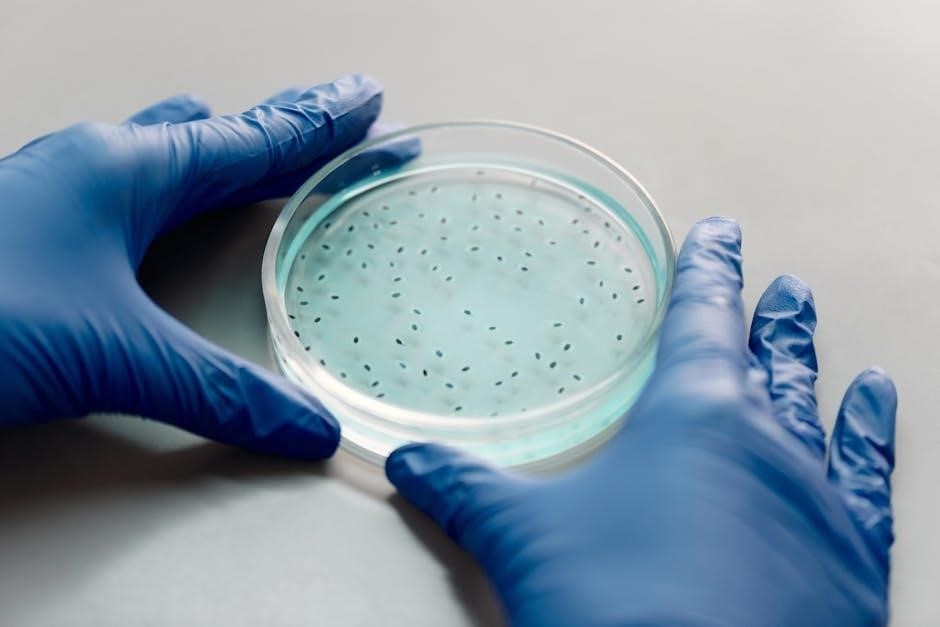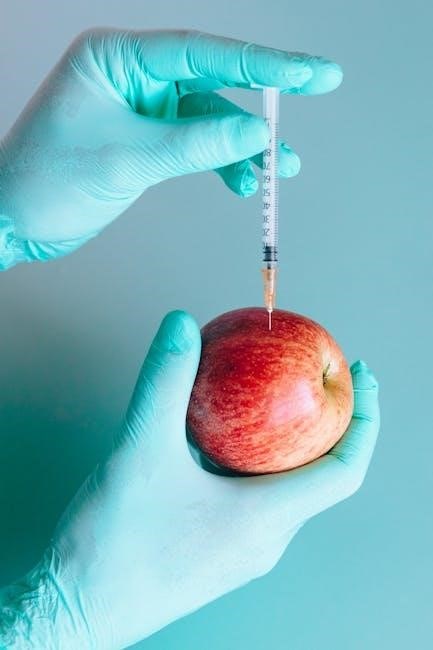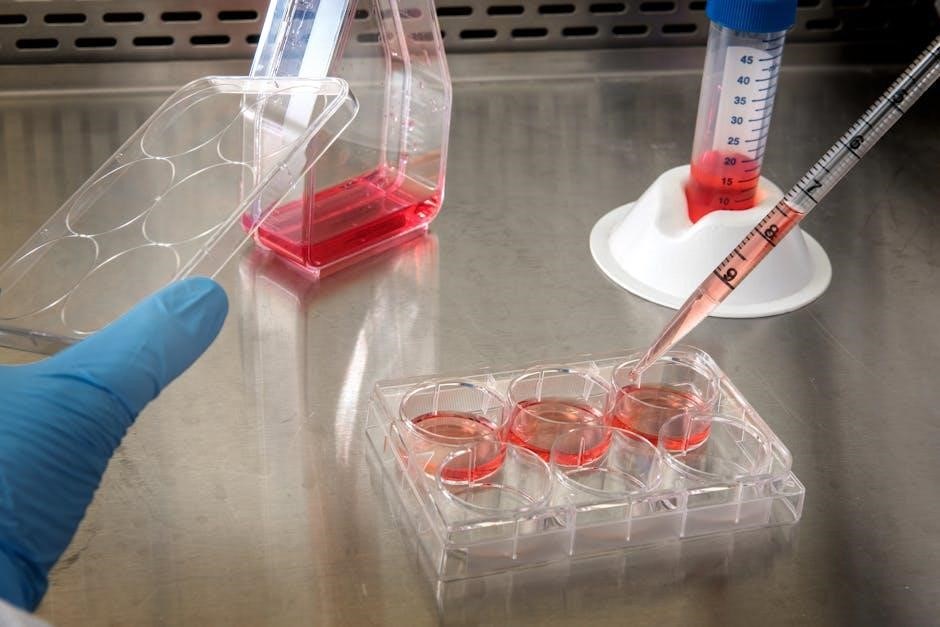AP Biology practice tests are an essential study tool for mastering exam content and improving test-taking skills. They provide realistic exam simulations, helping identify knowledge gaps and build confidence. With PDF resources available from College Board and third-party sites, students can access comprehensive practice materials to refine their strategies and achieve success.
Why Practice Tests Are Essential for AP Biology Preparation
Practice tests are vital for AP Biology preparation as they simulate real exam conditions, helping students assess their readiness. They identify knowledge gaps, allowing focused revision and improved understanding of key concepts. Regular practice enhances time management skills, ensuring students can complete sections within allotted time. Additionally, practice tests build confidence by familiarizing students with question formats, such as multiple-choice and free-response questions. Analyzing mistakes from practice tests provides insights into common errors, enabling targeted study. Ultimately, consistent use of practice tests optimizes exam performance and reduces test-day anxiety, making them an indispensable tool for achieving success on the AP Biology Exam.
Overview of the AP Biology Exam Format
The AP Biology Exam is a 3-hour assessment divided into two main sections: multiple-choice and free-response. Section I consists of 60 multiple-choice questions, with Part A (63 questions) and Part B (6 grid-in questions), lasting 1 hour and 30 minutes. Section II includes 6 free-response questions, such as experimental design and data analysis, completed in 1 hour and 45 minutes. The exam evaluates understanding of key biological concepts, scientific inquiry, and critical thinking. Practice tests mirror this format, helping students familiarize themselves with timing, question types, and content emphasis. This structure ensures a comprehensive evaluation of a student’s mastery of AP Biology material.

Structure of the AP Biology Exam
The AP Biology Exam is a 3-hour test divided into two sections: multiple-choice (60 questions) and free-response (6 questions). Practice tests mirror this format, ensuring realistic preparation.
Multiple-Choice Section: Format and Timing
The multiple-choice section of the AP Biology exam consists of 60 questions divided into two parts: Part A (63 questions) and Part B (6 grid-in questions). Students have 1 hour and 30 minutes to complete this section. Part A focuses on standard multiple-choice questions, while Part B requires numerical answers. Practice tests mirror this format, helping students manage time effectively and familiarize themselves with question types. The section assesses knowledge across all AP Biology topics, emphasizing critical thinking and problem-solving skills. Accurate time management is crucial, as each question is weighted equally, and improper pacing can impact performance. Utilizing practice tests is key to mastering this section’s demands.
Free-Response Section: Format and Timing
The free-response section of the AP Biology exam includes 8 questions, with 1 hour and 30 minutes allocated for completion. Students must answer 2 long essay questions and 6 shorter prompts, covering topics like experimental design, data analysis, and biological concepts. Practice tests provide sample questions and scoring guidelines, allowing students to refine their answer structure and content depth. Timing is critical, as each question is weighted equally. Effective time management and clear, concise writing are essential to score well. Utilizing practice tests helps students adapt to the exam format and improve their ability to articulate complex biological concepts within the allotted time frame, ensuring optimal performance on exam day.

Where to Find AP Biology Practice Tests
Official College Board resources, third-party websites, and study guides offer free and paid AP Biology practice tests in PDF format, providing convenient exam preparation tools.
Official College Board Resources
The College Board offers authentic AP Biology practice tests through their official website and course materials. These resources include past exams, scoring guidelines, and detailed explanations. Students can access free-response questions and sample answers to understand grading standards. Additionally, the College Board provides modified practice exams, such as the 2013 AP Biology Exam, which are ideal for self-assessment. These materials are designed to align with the current course framework, ensuring relevance and accuracy. By utilizing these official resources, students can gain a comprehensive understanding of the exam format and content, helping them prepare effectively for test day.
Third-Party Websites and Study Guides
Beyond official College Board materials, third-party websites and study guides offer additional AP Biology practice test PDFs. Platforms like Barron’s and online education portals provide comprehensive practice exams with detailed answer explanations. These resources often include timed sections and focus on high-yield topics. Study guides, such as “Cracking the AP Biology Exam,” also offer strategic tips and practice questions. While these materials supplement official resources, they provide diverse question formats and in-depth review. Students can use them to target weak areas and refine test-taking strategies, enhancing their overall exam readiness and performance.

Understanding the Exam Content
AP Biology exams cover topics like cell biology, genetics, ecology, and evolution. Practice tests help master these areas, ensuring alignment with College Board specifications and exam readiness.
Key Topics Covered in AP Biology
AP Biology focuses on core concepts such as cell structure and function, photosynthesis, cellular respiration, genetics, evolution, and ecology. Students explore biological processes, from molecular mechanisms like DNA replication to broader ecological systems. Topics also include the structure and function of biomolecules, cell signaling, and the impact of environmental factors on biological systems. Practice tests emphasize these areas, ensuring comprehensive understanding and preparation for the exam. Mastery of these topics is crucial for success, as they form the foundation of both multiple-choice and free-response questions.
Focus Areas for Maximum Score Improvement
Students should concentrate on weak areas identified through practice tests, such as challenging topics like cellular respiration, genetics, and experimental design. Strengthening understanding of data analysis and lab-based questions can significantly improve free-response scores. Additionally, refining time management skills and applying effective strategies for multiple-choice questions are vital. Regular practice with full-length tests helps build stamina and reduces exam anxiety, ensuring optimal performance on test day. Targeted focus on these areas can lead to substantial score improvements and a deeper mastery of AP Biology concepts.

How to Use Practice Tests Effectively
Take regular practice tests to familiarize yourself with the exam format and timing. Review mistakes to understand and correct them, focusing on weak areas like cellular respiration and genetics. Use official resources and third-party materials to ensure variety and reliability. Simulate exam conditions, including timing and environment, to build stamina and reduce anxiety. After each test, revisit difficult topics in your notes or textbook to reinforce learning. Join study groups or seek teacher feedback for additional insights. Stay consistent, alternating between studying and testing to avoid burnout. Maintain a positive mindset, understanding that progress requires time and effort. By systematically applying these strategies, you can optimize your preparation and achieve a higher score on the AP Biology exam.
Simulating Exam Conditions
Simulating exam conditions during practice is crucial for building stamina and familiarity with the test format. Set a timer for each section, adhering to the 80-minute multiple-choice and 90-minute free-response timings. Create a quiet, distraction-free environment to mimic the actual test setting. Use official or third-party PDF practice tests to replicate the exam experience accurately. Complete each section in one sitting without breaks to build endurance. Afterward, review your performance to identify areas for improvement. This method helps reduce anxiety and ensures readiness for the real exam. Consistent simulation also enhances time management and decision-making skills under pressure, which are key to success.
Reviewing Mistakes and Weak Areas
Reviewing mistakes and weak areas is a critical step in improving performance on AP Biology practice tests. After completing a practice exam, thoroughly analyze incorrect answers to understand where gaps in knowledge exist. Focus on identifying patterns, such as consistent errors in cellular respiration or genetics questions. Use scoring guidelines and sample responses to assess your free-response answers, noting areas for improvement. Weak areas should guide targeted study sessions, ensuring focused revision. Regular review of mistakes helps refine understanding, reduce errors, and build confidence. By addressing weaknesses systematically, students can achieve significant score improvements and develop a stronger grasp of key biological concepts and problem-solving strategies.

Multiple-Choice Question Strategies
Mastering multiple-choice questions requires strategic approaches to optimize performance. Start by skimming through all questions to allocate time wisely. Read each question carefully, focusing on keywords and eliminating incorrect options. Use process of elimination to increase chances of selecting the right answer. For grid-in questions, ensure calculations are precise and units are consistent. Practice under timed conditions to simulate exam pressure. Review answer explanations to understand reasoning behind correct answers. Regularly test-taking builds familiarity with question formats and reinforces knowledge retention. Consistent practice enhances speed and accuracy, crucial for success in the multiple-choice section of the AP Biology exam.
Tips for Tackling Part A Questions
Part A of the AP Biology multiple-choice section consists of 63 questions, requiring efficient time management. Begin by skimming all questions to identify easier ones first, ensuring quick points. Prioritize questions with clear answers, leaving ambiguous ones for later. Use the process of elimination to narrow down options, as this increases the likelihood of selecting the correct answer. Pay close attention to terminology and biological concepts, as these are often tested. Avoid spending too much time on a single question—allocate about 1 minute per question. Practice under timed conditions to build speed and accuracy. Reviewing mistakes from practice tests helps refine strategies and improve understanding of common question patterns.
Mastering Part B Grid-In Questions
Part B of the AP Biology exam includes 6 grid-in questions, requiring precise calculation and analysis. These questions often involve data interpretation, mathematical computations, and application of biological principles. To excel, practice interpreting graphs, tables, and experimental data from practice tests. Focus on understanding the underlying concepts rather than memorizing formulas. Use the provided equations and constants wisely, ensuring accuracy in calculations. Time management is crucial—allow approximately 5 minutes per question. Reviewing past exams helps identify common question types and improves problem-solving skills. Pay attention to units and significant figures to avoid errors. Utilize practice tests to refine your approach and build confidence in tackling these challenging questions effectively.

Free-Response Section Strategies
The free-response section assesses critical thinking and conceptual understanding. Practice tests help refine essay-writing skills, emphasizing clear, concise explanations and proper use of biological terminology. Reviewing past exams provides insights into common question formats, enabling better preparation and time management during the actual test.
Approaching Experimental Design Questions
Experimental design questions require students to propose and evaluate scientific investigations. Start by identifying the research question and hypothesis. Clearly define variables (independent, dependent, controlled) and outline the procedure. Ensure the design includes controls, replication, and addresses potential confounding factors. Use diagrams or flowcharts if necessary. Practice tests reveal common pitfalls, such as lack of clarity or insufficient detail. Reviewing past exams helps refine strategies for articulating logical, feasible experiments. Focus on practicality and validity to demonstrate a deep understanding of scientific inquiry. Always summarize the purpose and expected outcomes to strengthen your response.
How to Answer Data Analysis Questions
Data analysis questions assess your ability to interpret and draw conclusions from biological datasets. Begin by carefully reading the question and understanding what is being asked. Identify key trends, patterns, and relationships within the data. Pay attention to axes labels, legends, and any provided context. Calculate necessary values, such as rates or percentages, and compare groups to identify statistical significance. Support your answers with specific evidence from the data, using clear and concise language. Practice tests highlight common challenges, such as misinterpreting graphs or miscalculations. Regular review of past exams helps improve accuracy and speed in data interpretation, ensuring precise and well-supported responses.

Common Mistakes to Avoid
Avoid rushing through questions and mismanaging time during practice tests. Common errors include misinterpreting data and overlooking key details in experimental design questions. Regular review helps mitigate these issues.
Time Management Pitfalls
One of the most common mistakes during the AP Biology exam is poor time management; Many students spend too much time on a single question, leaving insufficient time for others. This often leads to incomplete answers and missed opportunities for scoring. Rushing through questions can result in careless errors, particularly in the multiple-choice and free-response sections. To avoid this, practice pacing yourself during practice tests. Allocate specific time limits for each question type and stick to them. For example, spend no more than 1-2 minutes per multiple-choice question and 15-20 minutes per free-response question. Use practice tests to refine your timing strategy and ensure you complete all sections without stress. Proper time management is key to maximizing your score.

Common Misconceptions in AP Biology
Several common misconceptions in AP Biology often hinder student understanding. One is the belief that photosynthesis occurs only in chloroplasts, ignoring its light-dependent reactions in the thylakoid membrane. Another is confusing mitosis and meiosis, thinking they produce identical cells. Students also mistakenly assume that all cellular respiration occurs in mitochondria, overlooking glycolysis in the cytoplasm. Additionally, many think natural selection acts on individuals rather than populations. These misunderstandings can lead to incorrect answers on practice tests. Addressing these through detailed study and practice exams helps clarify concepts and improves comprehension, ensuring a stronger foundation for exam success.

Sample Questions and Explanations
AP Biology practice test PDFs include sample multiple-choice and free-response questions with detailed explanations. These resources, like those from the College Board, mirror actual exam formats, helping students familiarize themselves with content and timing while identifying areas for improvement. Practice questions cover key topics such as cellular respiration, genetics, and ecology, providing clear answers to enhance understanding and exam readiness.
Multiple-Choice Question Examples
AP Biology practice test PDFs often include multiple-choice questions that mirror the actual exam. For example:
Question: “Which organelle is responsible for producing ATP in eukaryotic cells?”
Options: A) Chloroplast, B) Mitochondria, C) Nucleus, D) Endoplasmic Reticulum.
Answer: B) Mitochondria.
These questions cover core topics like cellular biology, genetics, and ecology. Practice tests also include explanations, helping students understand concepts and improve problem-solving skills. Resources like College Board and third-party websites provide access to these examples, enabling students to simulate exam conditions and identify weak areas. Regularly reviewing these questions enhances test-taking strategies and builds confidence for the actual AP Biology Exam.
Free-Response Question Examples
Free-response questions in AP Biology practice test PDFs require detailed, analytical answers. For example:
Question: “Explain how cellular respiration generates ATP in aerobic and anaerobic conditions.”
Students must describe the processes, including glycolysis, Krebs cycle, and electron transport chain, demonstrating understanding of energy production. Another example:
Question: “Design an experiment to test the effect of pH on enzyme activity. Include variables and expected outcomes.”
These questions assess critical thinking, scientific knowledge, and the ability to communicate complex ideas clearly. Practice tests provide scoring guidelines, helping students understand grading standards and improve their responses. Regular practice enhances writing and analytical skills, crucial for success on the AP Biology Exam.
Consistent practice with AP Biology PDFs is vital for exam success. Regular testing improves understanding, identifies weak areas, and builds confidence. Utilize official resources and study guides to master the material effectively.
Final Tips for Success
Consistent practice with AP Biology PDFs is key to mastering the exam. Regularly simulate test conditions to build time management skills and reduce anxiety. Review mistakes thoroughly to address weak areas and improve understanding. Utilize official College Board resources and third-party study guides for comprehensive preparation; Focus on high-yield topics and experimental design questions to maximize score improvement. Stay organized, maintain a study schedule, and prioritize active learning techniques. By combining targeted practice with strategic review, students can confidently approach the AP Biology Exam and achieve their desired results.
The Importance of Consistent Practice
Consistent practice with AP Biology PDFs is crucial for exam success. Regularly engaging with practice tests helps students become familiar with the exam format, timing, and content, reducing test-day anxiety. It also builds endurance for the 3-hour exam and sharpens critical thinking skills. By practicing consistently, students can identify and address weak areas, ensuring a well-rounded understanding of key topics like cellular biology and genetics. Additionally, consistent practice fosters time management skills and strategic guessing techniques, both of which are vital for maximizing scores. Using resources like College Board PDFs and third-party study guides ensures students are well-prepared for the challenges of the AP Biology Exam.